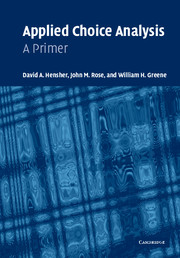Book contents
- Frontmatter
- Contents
- List of figures
- List of tables
- Preface
- Part I Basic topics
- 1 In the beginning
- 2 Basic notions of statistics
- 3 Choosing
- 4 Paradigms of choice data
- 5 Processes in setting up stated choice experiments
- 6 Choices in data collection
- 7 NLOGIT for applied choice analysis: a primer
- 8 Handling choice data
- 9 Case study: mode-choice data
- 10 Getting started modeling: the basic MNL model
- 11 Getting more from your model
- 12 Practical issues in the application of choice models
- Part II Advanced topics
- Glossary
- References
- Index
2 - Basic notions of statistics
Published online by Cambridge University Press: 05 September 2012
- Frontmatter
- Contents
- List of figures
- List of tables
- Preface
- Part I Basic topics
- 1 In the beginning
- 2 Basic notions of statistics
- 3 Choosing
- 4 Paradigms of choice data
- 5 Processes in setting up stated choice experiments
- 6 Choices in data collection
- 7 NLOGIT for applied choice analysis: a primer
- 8 Handling choice data
- 9 Case study: mode-choice data
- 10 Getting started modeling: the basic MNL model
- 11 Getting more from your model
- 12 Practical issues in the application of choice models
- Part II Advanced topics
- Glossary
- References
- Index
Summary
If scientific reasoning were limited to the logical processes of arithmetic, we should not get very far in our understanding of the physical world. One might as well attempt to grasp the game of poker entirely by the use of the mathematics of probability.
(Vannevar Bush 1890–1974)Introduction
This chapter is intended to act as a review of the basic statistical concepts, knowledge of which is required for the reader to fully appreciate the chapters that follow. It is not designed to act as a substitute for a good grounding in basic statistics but rather as a summary of knowledge that the reader should already possess. For the less confident statistician, we recommend that in reading this and subsequent chapters, that they obtain and read other books on the subject. In particular, we recommend for the completely statistically challenged Statistics without Tears: A Primer for Non-Mathematicians (Rowntree 1991). More confident readers may find books such as those by Howell (1999) and Gujarati (1999, chapters 2–5) to be of particular use.
Data
Data are fundamental to the analysis and modeling of real world phenomena such as consumer and organizational behavior. Understanding data are therefore critical to any study application and nowhere more than to studies involving discrete choice analysis. The data sets which we use, whether collected by ourselves or by others, will invariably be made up of numerous observations on multiple variables (an object that can take on many different values). Only through understanding the qualities possessed by each variable will the analyst be capable of deriving the most benefit from their data.
- Type
- Chapter
- Information
- Applied Choice AnalysisA Primer, pp. 8 - 61Publisher: Cambridge University PressPrint publication year: 2005



